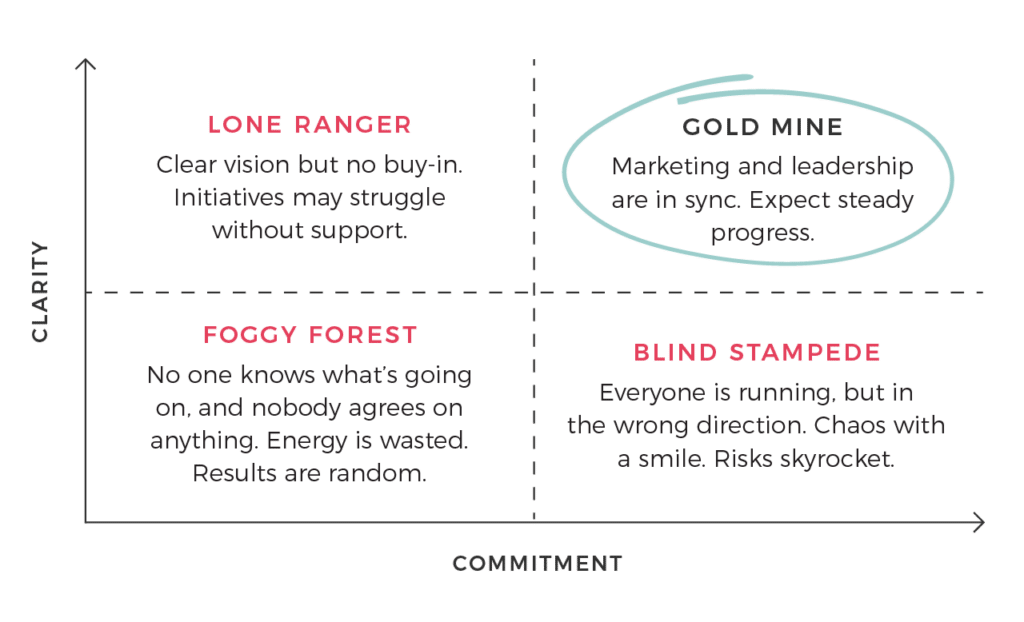We frequently talk about two types of “alignment.” One is ensuring your marketing activities—the day-to-day of your go-to-market—are connected to the goals and direction of the business as a whole.
The second type is internal alignment of your team—and that kind of alignment is the purpose of our discussion today. Great organizations possess a clarity of purpose and a commitment to working hard to achieve that purpose. When you share clarity and commitment all the way from your president or CEO down to the bottom of the org chart, that’s when your business really starts to meet its full potential.
But what does that type of alignment look like? And how can you identify when you don’t have it—or when your business has either clarity or commitment and lacks the other?
If you feel like your business is out of internal alignment, here’s what you should look for.
What is clarity?
Where is your business going? What are you trying to accomplish? If you can’t answer those questions, you lack clarity in your purpose and goals.
For Dan Pontefract, founder of the Pontefract Group and adjunct professor at the University of Victoria’s Gustavson School of Business, “without [clarity], there is no road map to the future” for a business. It also provides a framework for initiative—if employees know what the finish line is, they are more able to devise a smarter way to get there without needing leadership to hold their hands.
Clarity is how employees understand why their work matters, as well. Knowing the goal allows them to see how their contributions help the business move towards it. All of this helps build commitment to the cause.
What is commitment?
In the context of business, what we’re talking about here is a simple question an employee might ask: “Why should I care?”
Social scientists John Meyer and Natalie Allen provide us with a three-part structure to use to think about organizational commitment. They describe:
- Affective commitment (the desire to stay)
- Continuance commitment (the need to stay), and
- Normative commitment (the obligation to stay)
Continuance and normative commitment are table stakes for a business. Continuance commitment is based in things like salary and benefits being better here than elsewhere, or at least close enough to make leaving not worth the trouble. Normative commitment is based in a feeling that the organization would suffer if an employee left—that there would be a void left behind.
But affective commitment is the true motivator, and it’s what we’re mostly talking about here. Affective commitment means that the employee identifies with the company’s goals. They feel that they fit in well, and they’re satisfied with their work. They’re not staying because they fear what would happen if they left—they’re staying because they love it here, and they want to achieve the company’s goals.
In other words: Continuance and normative commitment keep your people from leaving. Affective commitment makes them want to stay.
A visualization of alignment
Let’s get into what clarity and commitment—or a lack thereof—look like in an organization. Imagine a chart, where “clarity” is measured on the vertical axis and “commitment” on the horizontal axis. It’s divided into four quadrants:

Here’s what each situation looks like.
Low clarity, low commitment: The Foggy Forest
Here, your employees are lost. They don’t know what you’re doing—as a leadership team or as a business—and they certainly don’t know why you’re doing it. In large part because of this, they also don’t really care. They are not dedicated to the business’s outcomes. Results are random at best, and the chances are that good results are uncommon.
In the foggy forest, your employees are just here to pick up a paycheck. If they get that, they don’t really care about the business’s bottom line. And if they don’t, they won’t hesitate to jump ship at the first opportunity because they’re likely unhappy about the lack of direction and frequent confusion anyway.
Low clarity, high commitment: The Blind Stampede
Things are a little bit better here. Your culture is strong. There’s energy and belief behind what the business is doing. People want to be here, and they want to work hard to achieve your organization’s goals.
The problem? Those goals may not be the same for everyone. There may be disagreement between leadership and the rest of the business, or perhaps even among different members of the leadership team. And even if the goals are agreed upon and clear, the route to get there may not be.
At an organization that’s experiencing a blind stampede, there are a lot of passionate people running fast and working hard. But they’re running in different directions, and they’re not getting consistent results. Frustration may ensue if goals are consistently not being met, and even a strong culture may not protect against it.
High clarity, low commitment: The Lone Ranger
This organization has a few individuals who are working very hard on something they feel very clear on. They know the objectives and are highly motivated to reach them. But as a whole, the business lacks the energy and the will to get things done.
The people who are active will feel like they’re on an island. The people around them are not supporting the outcomes leadership is looking for. And it’s easy for these lone rangers to burn out.
The issue could be that the leader or leaders of the organization haven’t effectively communicated those clear goals and outcomes to the business. Everyone who’s supposed to be running alongside leadership hasn’t caught up. That lack of communication can make it difficult for the organization as a whole to really care.
Another possibility: the outcomes leadership is chasing aren’t things that will drive the rest of the people within the business. If everyone understands what the goal is and motivation is low, the goal itself may be the issue.
High clarity, high commitment: Alignment
The leadership team has strong goals, and communicates them clearly to the rest of the organization. Employees know what they’re doing, they know what they’re working toward, and they believe strongly in the goals and the process. There’s one outcome that everyone agrees upon, and the organization’s focus and goals are oriented toward reaching it.
This is the gold standard for a business. Everyone within the organization is working towards the same clear goal, and they’re all excited to be doing it.
How can a business achieve alignment?
This doesn’t just happen. It takes work, and it takes effort—particularly from leadership. If you’re questioning whether your business is in alignment, ask yourself (and the rest of your leadership team) a few questions.
What is your goal? What are you chasing after? How will you measure success—what does it look like to be really great at what you do? These answers will help lead you toward clarity. Why do you feel like this is the wrong way to do this? Why would your direction lead to a better outcome? These questions lead toward solving commitment issues.
It will take time and energy to identify your organization’s issues, and to work towards solving them. But alignment across your business is well worth the investment.




